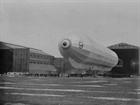On this day 27 November 1916
R9 makes the first successful flight by RN rigid airship
The failure of HMA1 'Mayfly' set back research into rigid airships. Although the contract for R9 this was signed in March of 1914; work was suspended in the following February and begun again in July, 1915, but it was not until January of 1917 that the ship was finished, while her trails were not completed until March of 1917, when she was taken over by the Admiralty.
British Rigid Airship R9, by Vickers, made her first flight on 27 November 1916. She made a rather remarkable passage to Howden through a snowstorm over the Pennine range. Being somewhat inadequate in buoyancy, she was used for instruction and ultimately for mooring experiments.
The details of the construction and trial of this vessel, show that she did not quite fill the contract requirements in respect of disposable lift until a number of alterations had been made. The contract specified that a speed of at least 45 miles per hour was to be attained at full engine power, while a minimum disposable lift of 5 tons was to be available for movable weights, and the airship was to be capable of rising to a height of 2,000 feet. Driven by four Wolseley Maybach engines of 180 horse-power each, the lift of the vessel was not sufficient, so it was decided to remove the two engines in the after car and replace them by a single engine of 250 horsepower. With this the vessel reached the contract speed of 45 miles per hour with a cruising radius of 18 hours, equivalent to 800 miles when the engines were running at full speed. The vessel served admirably as a training airship, for, by the time she was completed, the No. 23 class of rigid airship had come to being, and thus No. 9 was already out of date.


